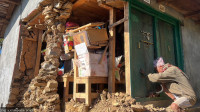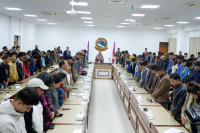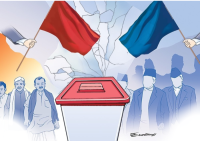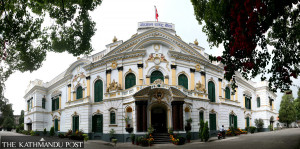Columns
A vision for sustainable tourism
The entire country could learn lessons from the sustainable tourism drive occurring in the Shey Phoksundo trail.
Amir R Thapa
In 2019, multiple blogs and travelogues were published about the Dolpo region, with a special focus on the Shey Phoksundo trail. Social media was abuzz with numerous colourful pictures and stories by trekkers. Some were fascinated by the airport in Jufal, while others were stunned by the waterfall in the Phoksundo River that runs along the trail and eventually merges with the Bheri River in Suligadh. Some focused on the Dhaulagiri range while others discovered the unique landscape and the Bon rituals still practised by people in the region. Everyone was impressed by the majestic blue lake situated at 3,600 m that changes colour every now and then. Every visitor seemed enchanted by Shey Phoksundo, the deepest lake in the country.
Statistics published by the Shey Phoksundo National Park show that the number of tourists in the region has increased impressively in the last couple of years. The increment was possible largely due to internal tourists. Internal tourism has flourished in Nepal, largely because of a new generation of adventurous young adults. Ranjit Shah from Janakpur scaled Mt Amadablam and has the ambition to climb Everest, while numerous local tourists have started flocking to the Mardi Himal trekking route. This new shift towards travelling is a testament to the country’s unparalleled natural beauty. These young adults are our most important brand ambassadors when it comes to promoting tourism. One of the most remarkable examples was Nirmal Purja’s Project Possible. By climbing all fourteen peaks that are over 8000 meters within six months, Mr Purja set a new record and became a national icon.
The government has launched Visit Nepal 2020 intending to usher in 2 million tourists to Nepal. A campaign of this magnitude was conceptualised to enhance the economic prosperity of the country that was ravaged by the 2015 earthquake. It is a campaign recommended by various experts working on the post-disaster scenario. There are severe criticisms of this campaign, most of which highlight the country’s poor infrastructure. The country’s only international airport is in shambles and many scenic destinations do not have proper facilities. But we all need to join hands to make this campaign successful. Nepal’s civil society needs to join hands with the private sector to support the government’s vision.
I work for a social entity that has been working to enhance the experience of tourists in the Dolpo region, especially those who trek to the Shey Phoksundo Lake. Throughout its planning, the project has focused on sustainability. An Eco Lodge project, it has combined socio-cultural aspects with socioeconomics, intending to support and revive existing hotels and lodges in the region. Started in 2017, six lodges along the Juphal-Dunai-Shey Phoksundo trail have been identified. By providing basic necessities as well as aesthetics, the project intends to increase the hotel owners’ income which would, in turn, benefit the broader community. Despite severe logistical and topographic challenges, lodges in Jufal, Kagani, Dunai, Ryachi, Bagral and Rigmo have been renovated and are ready to welcome tourists.
In the past, most tourists trekking to the Dolpo region brought their camping gear and food stock. But a team was sent off to Dolpo for basic assessment to develop a comprehensive programme to put Dolpo’s Shey Phoksundo trail on the global trekking map. Since then, discussions with local stakeholders have taken place, with a concerted effort to inject the idea of sustainability. One local, Rigzin Budha, was given hospitality management training in Kathmandu. Rigzin is now back in his hotel in Rigmo, coordinating with the other hotel owners to share his knowledge from the training. The community has gradually understood the value of eco-tourism and sustainability.
Today, tourists visiting Dolpo and the Shey Phoksundo trekking trail can find a lot more information. They can track themselves while walking on the path as milestone posts are posted in various locations. People are aware that animals like blue sheep, snow leopard, and musk deers have their habitats within Dolpo’s National Parks. There are rooms where people can sleep comfortably now. There are toilets and bathing areas where tourists can freshen up after a long day’s trek. Integrating local culture and regional beauty to infrastructural development was the principal lesson transferred to the villagers during this project. Every house owner need not be a hotel owner. Sustainable tourism requires chicken farmers, organic farmers, cheese producers. Young people also need other skills such as plumbing and mechanical training.
This project could be an example for the entire tourism sector. If this idea could be transferred throughout the country, Visit Nepal 2020 would indeed be an exemplary campaign. The Tourism Ministry, along with the Visit Nepal 2020 team, should also start thinking seriously about sustainable tourism. If we are serious about expanding Nepal’s tourism potential, training to taxi drivers and bus drivers, along with specialised training to guides and porters, could be an initial beginning for sustainable tourism development.
***
What do you think?
Dear reader, we’d like to hear from you. We regularly publish letters to the editor on contemporary issues or direct responses to something the Post has recently published. Please send your letters to [email protected] with "Letter to the Editor" in the subject line. Please include your name, location, and a contact address so one of our editors can reach out to you.




 18.12°C Kathmandu
18.12°C Kathmandu















